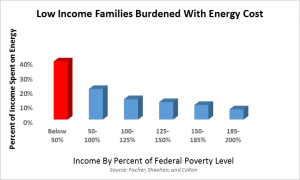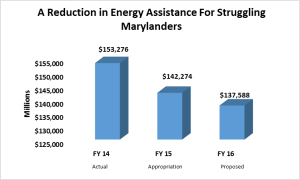State of Working Maryland: Many Marylanders Remain Burdened With Energy Expenses
Despite a decline in energy costs over the past year, many Marylanders’ continue to struggle with their energy expenses.
Over the past year the price of crude oil has fallen dramatically, resulting in lower gasoline, diesel fuel, and heating oil prices. As a result, consumer costs for each of these products has fallen by approximately 1 dollar per gallon.
The price of natural gas has also dropped. But the extreme weather this winter has offset family savings from lower prices.
To make matters worse, families struggling to heat their homes are getting less help. The budget for the Office of Home Energy Programs, which helps low-income Marylanders afford heating and other energy bills, was cut by $11 million in the current budget. Governor Hogan has proposed cutting home energy assistance in the next fiscal year (which starts July 1) by another $4.6 million. The two-year sum of these reductions is $15.6 million or 10.8 percent.
Across-the-board federal spending cuts, known as the “sequester,” also hit OHEP. However, energy assistance in the next budget will decline solely as a result of cuts made at the state level. In fact, next year Maryland benefits from a 2.4 percent increase in federal energy assistance funds, while the state will be decreasing the amount it contributes by 8.2 percent.
Low-income residents, particularly the 26 percent of Marylanders living below 200 percent of the federal poverty level (FPL) experience the most hardship in keeping up with their energy costs. Energy costs are considered affordable when they do not exceed 6 percent of household income.
The size of the burden varies by income—from those with incomes below 50 percent of the FPL $9,895 for a family of three) paying 40 percent of their income for energy, to those with incomes at 199 percent of the FPL ($39,500 for a family of three) paying 8 percent. This contrasts sharply with those above 200 percent of the FPL who pay from 6 percent down to below 1 percent.

Home energy assistance is not only integral to combating poverty in Maryland, it also provides funding for investments in energy efficiency and renewable energy technologies. The cuts proposed by Governor Hogan would mean fewer families would be able to heat their homes, and homeowners and landlords would l be less likely to improve energy efficiency. State policymakers should protect state investments in making energy affordable for Maryland families.
Today’s blog post is the third in our State of Working Maryland series looking at demographic and economic trends in the state. Previously, this has been an annual publication. This year we will instead publish occasional blogs and research briefs on topics affecting working families in Maryland.

